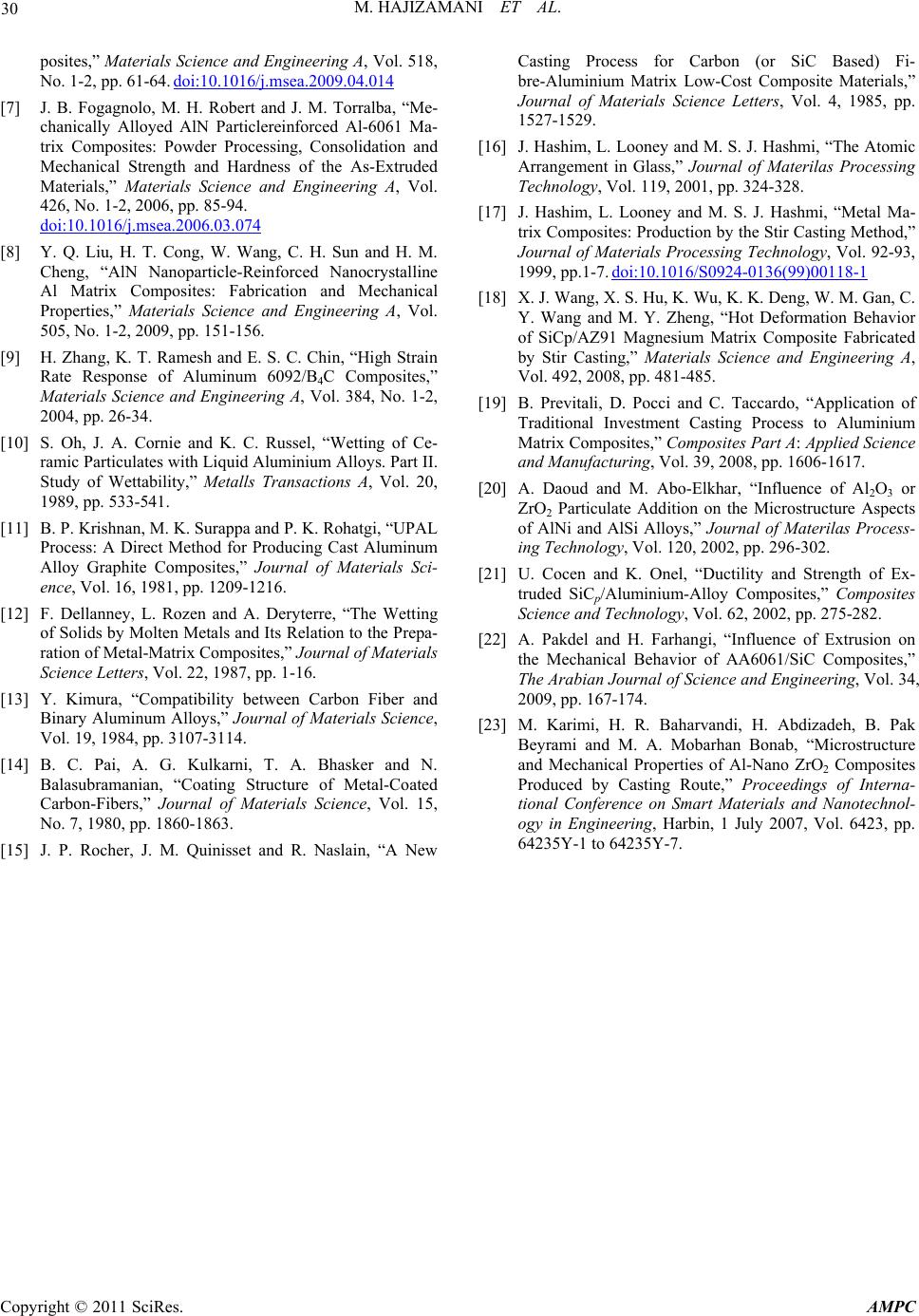
M. HAJIZAMANI ET AL.
Copyright © 2011 SciRes. AMPC
30
posites,” Materials Science and Engineering A, Vol. 518,
No. 1-2, pp. 61-64. doi:10.1016/j.msea.2009.04.014
[7] J. B. Fogagnolo, M. H. Robert and J. M. Torralba, “Me-
chanically Alloyed AlN Particlereinforced Al-6061 Ma-
trix Composites: Powder Processing, Consolidation and
Mechanical Strength and Hardness of the As-Extruded
Materials,” Materials Science and Engineering A, Vol.
426, No. 1-2, 2006, pp. 85-94.
doi:10.1016/j.msea.2006.03.074
[8] Y. Q. Liu, H. T. Cong, W. Wang, C. H. Sun and H. M.
Cheng, “AlN Nanoparticle-Reinforced Nanocrystalline
Al Matrix Composites: Fabrication and Mechanical
Properties,” Materials Science and Engineering A, Vol.
505, No. 1-2, 2009, pp. 151-156.
[9] H. Zhang, K. T. Ramesh and E. S. C. Chin, “High Strain
Rate Response of Aluminum 6092/B4C Composites,”
Materials Science and Engineering A, Vol. 384, No. 1-2,
2004, pp. 26-34.
[10] S. Oh, J. A. Cornie and K. C. Russel, “Wetting of Ce-
ramic Particulates with Liquid Aluminium Alloys. Part II.
Study of Wettability,” Metalls Transactions A, Vol. 20,
1989, pp. 533-541.
[11] B. P. Krishnan, M. K. Surappa and P. K. Rohatgi, “UPAL
Process: A Direct Method for Producing Cast Aluminum
Alloy Graphite Composites,” Journal of Materials Sci-
ence, Vol. 16, 1981, pp. 1209-1216.
[12] F. Dellanney, L. Rozen and A. Deryterre, “The Wetting
of Solids by Molten Metals and Its Relation to the Prepa-
ration of Metal-Matrix Composites,” Journal of Materials
Science Letters, Vol. 22, 1987, pp. 1-16.
[13] Y. Kimura, “Compatibility between Carbon Fiber and
Binary Aluminum Alloys,” Journal of Materials Science,
Vol. 19, 1984, pp. 3107-3114.
[14] B. C. Pai, A. G. Kulkarni, T. A. Bhasker and N.
Balasubramanian, “Coating Structure of Metal-Coated
Carbon-Fibers,” Journal of Materials Science, Vol. 15,
No. 7, 1980, pp. 1860-1863.
[15] J. P. Rocher, J. M. Quinisset and R. Naslain, “A New
Casting Process for Carbon (or SiC Based) Fi-
bre-Aluminium Matrix Low-Cost Composite Materials,”
Journal of Materials Science Letters, Vol. 4, 1985, pp.
1527-1529.
[16] J. Hashim, L. Looney and M. S. J. Hashmi, “The Atomic
Arrangement in Glass,” Journal of Materilas Processing
Technology, Vol. 119, 2001, pp. 324-328.
[17] J. Hashim, L. Looney and M. S. J. Hashmi, “Metal Ma-
trix Composites: Production by the Stir Casting Method,”
Journal of Materials Processing Technology, Vol. 92-93,
1999, pp.1-7. doi:10.1016/S0924-0136(99)00118-1
[18] X. J. Wang, X. S. Hu, K. Wu, K. K. Deng, W. M. Gan, C.
Y. Wang and M. Y. Zheng, “Hot Deformation Behavior
of SiCp/AZ91 Magnesium Matrix Composite Fabricated
by Stir Casting,” Materials Science and Engineering A,
Vol. 492, 2008, pp. 481-485.
[19] B. Previtali, D. Pocci and C. Taccardo, “Application of
Traditional Investment Casting Process to Aluminium
Matrix Composites,” Composites Part A: Applied Science
and Manufacturing, Vol. 39, 2008, pp. 1606-1617.
[20] A. Daoud and M. Abo-Elkhar, “Influence of Al2O3 or
ZrO2 Particulate Addition on the Microstructure Aspects
of AlNi and AlSi Alloys,” Journal of Materilas Process-
ing Technology, Vol. 120, 2002, pp. 296-302.
[21] U. Cocen and K. Onel, “Ductility and Strength of Ex-
truded SiCp/Aluminium-Alloy Composites,” Composites
Science and Technology, Vol. 62, 2002, pp. 275-282.
[22] A. Pakdel and H. Farhangi, “Influence of Extrusion on
the Mechanical Behavior of AA6061/SiC Composites,”
The Arabian Journal of Science and Engineering, Vol. 34,
2009, pp. 167-174.
[23] M. Karimi, H. R. Baharvandi, H. Abdizadeh, B. Pak
Beyrami and M. A. Mobarhan Bonab, “Microstructure
and Mechanical Properties of Al-Nano ZrO2 Composites
Produced by Casting Route,” Proceedings of Interna-
tional Conference on Smart Materials and Nanotechnol-
ogy in Engineering, Harbin, 1 July 2007, Vol. 6423, pp.
64235Y-1 to 64235Y-7.